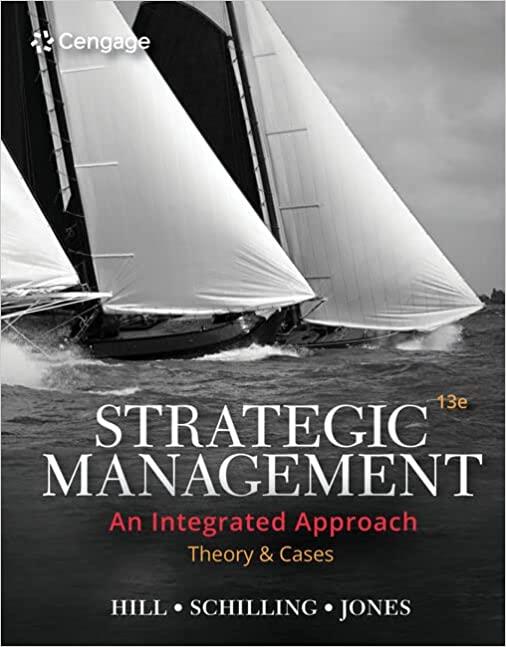At a dinner for Silicon Valley luminaries in February 2011, U.S. President Barack Obama asked Steve Jobs
Question:
At a dinner for Silicon Valley luminaries in February 2011, U.S. President Barack Obama asked Steve Jobs of Apple, “What would it take to make iPhones in the United States?” Jobs replied, “Those jobs aren’t coming back.” Apple’s management had concluded that overseas factories provided superior scale, flexibility, diligence, and access to industrial skills—“Made in the U.S.A.” just did not make sense for Apple anymore.
As an example of the superior responsiveness of Chinese factories to Apple’s needs, an executive described a recent event when Apple wanted to revamp its iPhone manufacturing just weeks before it was scheduled for delivery to stores. At the last minute, Apple had redesigned the screen, and new screens arrived at the Chinese factory at midnight.
Fortunately, the 8,000 workers slept in dormitories at the factory—they were woken, given a cookie and a cup of tea, and were at work fitting glass screens into their beveled frames within 30 minutes. Soon the plant was producing 10,000 iPhones per day. The executive commented, “The speed and flexibility is breathtaking . . . There’s no American plant that can match that.”
“Foxconn City,” a complex where the iPhone is assembled, has 230,000 employees, many of whom work 6 days a week and up to 12 hours a day. It is owned by Foxconn Technology, which has dozens of factories in Asia, Eastern Europe, Mexico, and Brazil. It is estimated that Foxconn assembles 40% of the world’s consumer electronics. It boasts a customer list that includes Amazon, Dell, Hewlett-Packard, Motorola, Nintendo, Nokia, Samsung, and Sony, in addition to Apple. Foxconn can hire thousands of engineers overnight and house them in dorms—something no American firm could do. Nearly 8,700 industrial engineers were needed to oversee the 200,000 assemblyline workers required to manufacture iPhones. Apple’s analysts estimated that it could take 9 months to find that many qualified engineers in the United States. It only took 15 days in China. Moreover, China’s advantage was not only in assembly; it also offered advantages across the entire supply chain. As noted by an Apple executive, “The entire supply chain is in China now. You need a thousand rubber gaskets? That’s the factory next door. You need a million screws? That factory is a block away. You need that screw made a little bit different? It will take three hours.” Of Apple’s 64,000 employees, nearly one-third are outside of the United States. In response to criticisms about failing to support employment in its home country, Apple executives responded, “We sell iPhones in over a hundred countries. . . . Our only obligation is making the best product possible.”
Although Apple epitomizes the opportunities for strategic outsourcing, it is also—paradoxically, perhaps—more vertically integrated than most computer or smartphone firms. Apple’s decision to produce its own hardware and software—and tie them tightly together, and sell them its own retail stores—was widely known and hotly debated. However, the vertical integration did not end there. Apple also spends billions of dollars buying production equipment that is used to outfit new and existing Asian factories that will be run by others (an example of quasivertical integration), and then requires those factories to commit to producing for Apple exclusively.
By providing the upfront investment, Apple removes most of the risk for its suppliers in investing in superior technology or scale. For decades, the computer and mobile phone industries have been characterized by commoditization and rapid cost reduction.
Suppliers had to work hard to reduce costs to win competitive bids, and standardized production facilities trumped specialized facilities as they enabled suppliers to smooth out volatility in scale by working with multiple buyers. This meant that most suppliers to the computer and phone industry could produce cost-efficient hardware, but not “insanely great” hardware. Apple’s strategy of paying upfront for both the technology and capacity enabled it to induce its suppliers to make specialized investments in technologies that were well beyond the industry standard, and to hold excess capacity that would enable rapid scaling. The net result is that Apple develops superior flexibility and technological sophistication that its competitors cannot match.
Seeming to acknowledge the advantages of Apple’s strategy of controlling device design and production, Microsoft announced in 2012 that it too would design and produce its own tablet, the Surface. It also launched its own chain of dedicated Microsoft retail stores that looked remarkably similar to Apple stores.
Both moves proved challenging at Microsoft; it lacked both the tightly woven ecosystem that Apple has developed around those strategies, and its decades of experience in implementing them. In 2013, Microsoft had to take a $900-million writedown due to the spectacular failure of the Surface RT. But Microsoft stuck with the Surface, and the product ultimately grew to account for roughly $5 billion in revenues in 2017– roughly 20% of Apple’s Mac sales. Microsoft’s retail move does not appear to have been as successful.
Though Microsoft had roughly 20% of the number of stores of Apple in 2018 (102 for Microsoft versus 502 for Apple), its sales per square foot were estimated to be a small fraction of those at Apple, which at $5,546 per square foot was the top retailer in the world.
Questions
1. What are the advantages and disadvantages to Apple of outsourcing its production to factories in China?
2. What factors influence the choice of countries to which a firm might outsource its production?
3. Is there anything that might cause Apple to eventually shift production back to the United States?
4. Why is Apple more vertically integrated than many other computer makers?
5. What factors will help or impede Microsoft in matching the advantages Apple gains from its vertical integration strategies?
Step by Step Answer:

Strategic Management Theory And Cases An Integrated Approach
ISBN: 9780357033845
13th Edition
Authors: Charles W. L. Hill, Melissa A. Schilling, Gareth R. Jones





